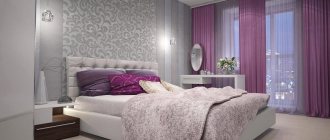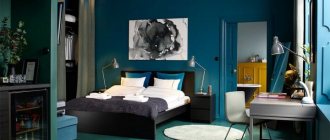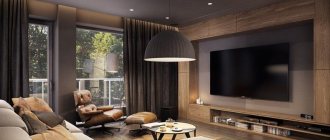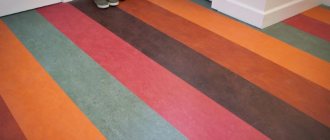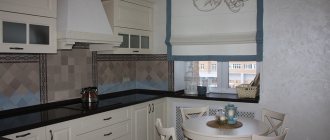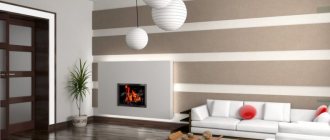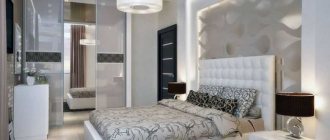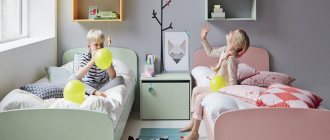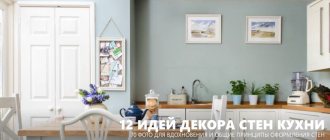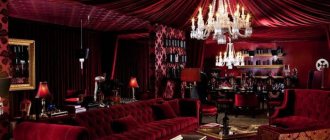The design of any room acquires character thanks to the main components - shape and color. If the shape and combination of lines convey the style direction, then the predominant color is a factor that expresses the mood of the room, shapes its character and complements the design. Naturally, most interiors use a combination of colors. Even when decorated in a monocolor solution, there are minor color spots that are accentuated. It is important that the shades match. But in each case of interior design there is one color, which is the base color and is applied to the walls.
How to decorate the color of the walls in the kitchen will be discussed in this article.
Tips for choosing colors
Basic rules for color decoration of walls:
- Dark colors visually conceal and reduce the area of the room, while light colors significantly increase it. Therefore, to decorate a small kitchen you should choose pastel shades.
- It is not advisable to use cold colors in a kitchen that is too spacious, as this will have an unfavorable effect on the decor and will cause a feeling of spatial emptiness.
- Shades of the dark color spectrum should be used for kitchens located on the sunny side. Bright and light colors are suitable for rooms that are in the shade most of the time.
- Feng Shui recommends choosing cool or light shades, such as white, green, light yellow, beige, light brown or blue.
- In a room with walls in discreet colors, you should create bright accents through contrasting furniture, curtains, chair upholstery or textiles.
Important parameters
The walls in the kitchen create the backdrop for the overall style, so it is important to understand the basic rules:
- Use light colors to visually expand the room.
- If you have a small kitchen, avoid dark colors as they narrow the area.
- If the area is small, do not use bright colors.
- For a large space, use warm shades, because cold shades visually enlarge the room, and the kitchen feels empty and impersonal.
On the market of construction and finishing materials you can buy any color of paint, different textures. When renovating, you don’t need to chase fashion trends.
Nowadays they often paint them chestnut and black, but this is not the best option for kitchens. Such a solution will make the room smaller and make it gloomy, even with good lighting. In addition, dark colors can negatively affect a person’s mood.
Studying photo ideas for kitchens, you will notice that not only the walls, but also the ceiling can be painted. Many are accustomed to white color, with an even structure, but if there is height and area, it is recommended to do it in several levels using drywall.
Stretch ceilings made of film would be a great idea. Both options can also be combined and painted in different colors.
For a small room with a low ceiling, it is important to stick to the classics in white or pastel colors to visually expand the space. Light gloss is suitable for suspended ceilings.
Ideas for combining wall colors and furniture
If the set is made in bright, eye-catching colors, then it would be advisable to paint the walls in calmer and neutral colors or vice versa. For example, brown, green, orange or blue wall colors are perfect for a white set.
The photo shows a white kitchen set in combination with blue walls.
You can also create a bright color accent by decorating the apron in the opposite color of the kitchen set.
Advantages of coatings
An excellent choice for the kitchen is washable paint.
Designers have been using paint and varnish materials when decorating for quite some time now, instead of standard wallpaper, tiles or panels.
Why is paint preferable for decorating kitchen walls? The answer to this question is quite simple. The widest palette and the ability to mix tones allows you to choose absolutely any shade. Practicality, low cost, ease of care and application make paint and varnish materials indispensable for designers. Housewives value them for their excellent moisture resistance, wear resistance, resistance to various mechanical influences and the ease of changing the interior.
The most popular wall colors in the interior
The color palette of the walls is considered the most important element in decorating a kitchen; the entire appearance of the interior will depend on the correct shade.
White
It will undoubtedly give the room additional volume, brightness and snow-white cleanliness. This color is quite controversial, as it has a huge variety of different shades: chalky, milky, creamy or opal.
White brings graphics and style to the interior; it perfectly emphasizes the volume and texture of other decorative elements, without drawing attention to itself.
Blue
An extravagant, but at the same time very harmonious blue shade is very relevant in the design of walls in the kitchen. This sea green color always looks simply gorgeous and forms a light, airy design.
The photo shows a small kitchen with walls decorated with blue wallpaper.
Red walls
Burgundy walls will add some piquancy to the room and make the interior more active and pronounced.
The photo shows a wall with burgundy wallpaper in the interior of a classic kitchen.
Complex, bright and deep red tones look bold, extravagant in the kitchen and attract all attention.
Such colors radically transform the room, making it truly stylish, fashionable and attractive. This wall design is very bold and extraordinary, and is perfect for creating exclusive and memorable interiors.
Green color
It will fill the atmosphere with the aroma of summer greenery and optimism. Green, pistachio or lime will enliven the space and add juiciness to it.
The photo shows the interior of a modern kitchen with green walls.
Shades of green
Natural green shades always have a very beneficial effect on the atmosphere in the room.
Mint
Copes perfectly with both the main and secondary roles in kitchen design. The menthol shade brings freshness to the space, a feeling of languid coolness and combines beautifully with almost all colors.
Mint, due to its natural appearance, is pleasing to the eye, does not cause fatigue or irritation, and does not get boring.
The photo shows a kitchen in light colors with a mint accent wall.
Olive
Natural, natural and warm olive tone allows you to create amazing, sophisticated and attractive color combinations, due to which you can change the design beyond recognition and make it truly extraordinary.
Light green
It will fill the environment with positive emotions and create a positive and cheerful atmosphere. The light green background in the kitchen space favorably emphasizes and highlights the rest, both dark and light interior elements.
Dark green
Deep and noble dark green will give the room a special mystery and give the interior a presentable appearance. However, this wall design should only be used in rooms with good lighting, so as not to create a gloomy and depressing environment.
The photo shows the interior of a classic kitchen with dark green wall decoration.
Grey colour
Gray or light grey, combine striking elegance and simplicity. Thanks to their restraint, they are a modern sign of good taste; they create complete harmony and balance in the room and fill it with a haze of mystery.
Pink
Delicate pink always creates a warm and homely comfortable atmosphere. Soft and refined shades make the design more sensual.
The photo shows a kitchen-dining room with bright walls painted pink.
Orange
Various shades of orange, such as pumpkin, amber or ocher, create a very warm, rich, tonic and filled with positive energy interior, while peach allows you to make wall decoration unobtrusive and subdued.
Beige
Due to its versatility, beige is often used to decorate kitchens with any style. This tone is considered neither warm nor cold and therefore allows you to create a very beautiful interior with a precise mood and style.
The photo shows a kitchen and walls decorated with beige wallpaper with a checkered print.
Brown
Chocolate and coffee shades are a classic option for creating a cozy and comfortable environment. Brown conveys nobility and high cost and is universal.
Blue
Cool and deep blues add color and accents to a space. Due to its royal coldness and a certain severity, this color is better suited for rooms located on the south side.
Yellow
Associated with the bright sun and undoubtedly fills the room with cheerfulness and energy. Yellow, mustard or lemon wall decor looks creative and creates a feeling of additional lighting in the room.
Black
Such a captivating and provocative color will undoubtedly become one of the main accents of the kitchen. Black in the interior looks simply amazing and is considered an indicator of chic, wealth and refined taste.
Violet
Lavender or lilac tones will create a sophisticated and sophisticated environment, filled with special romance and sensuality. Rich purple colors will add elegant luxury, bright expressiveness and originality to the design.
Let's sum it up
How to repair and paint kitchen furniture so that the result does not disappoint? First, assess the range of damage and the work required, then choose the best paint product. Thanks to high-quality paint for painting furniture, we don’t have to think about labor-intensive, thorough repairs and replacement of equipment. Why replace when you can extend life? All you have to do is change the color, tone or shade, and add a smart selection of accessories to create your dream kitchen with furnishings straight out of an interior design magazine.
As you can see, painting a kitchen is not only about renovation, but also about creativity. Now that you know how and with what to paint the kitchen facade with your own hands, you can safely get to work. The renovated room will not only be pleasant to be in, but also to cook, wash dishes, meet and communicate.
Color combinations
There is a monochromatic, neutral or contrasting color combination. When used correctly in the interior, it will be possible to most accurately convey the main idea of the room design.
The best color combinations
The most successful color combinations.
Black and white
This contrast radically corrects the appearance of the entire room and completely changes its mood and character. The black and white combination is a bright dominant feature, which results in a catchy and undeniably effective kitchen design.
Blue and white
The combination of blue and white gives the space a cohesive look. With proper proportional use of these colors, you can achieve truly excellent decorative results.
The photo shows a kitchen interior with a combination of white and blue colors on the wall.
Red with black
The most successful and very stylish two-color combination. Extravagant fiery red combined with luxurious black creates an incredible tandem that fills the space with solemnity, sensuality and elegant drama.
Shades “taken” from wallpaper
Interior designers recommend that part of the kitchen can be covered with wallpaper, and part can be painted. Colorful wallpapers can hide visually uncomfortable elements such as an air duct or a load-bearing column, but that’s not all: they can become a treasure trove of color solutions.
After all, in good wallpaper everything is very competent and professionally balanced. Just “get” the primary colors from them. You can make them lighter or darker, it’s your choice.
Author of the project: Evgenia Mishina. Photo: Sergey Krasyuk.
Author of the project: Evgenia Mishina. Photo: Sergey Krasyuk.
Photos in various interior styles
Each style direction has its own specific color character.
Classical
For the general background in the classics, discreet pastels, neutral, calm or noble shades are used. For example, it could be pale pink, beige, sand, pale blue, cream, pale yellow or other tones, diluted with large portions of white. Such discreet and muted wall decoration will become an integral part of this style.
Provence
Calm, seemingly slightly faded undertones, such as soft blue, lilac, olive, pink, beige with the addition of bright and rich accents in the form of cornflower blue, turquoise or amber yellow, will create an atmosphere as close as possible to French Provence.
The photo shows beige wall decoration in a kitchen made in Provence style.
Modern
For this style, a color scheme is appropriate that includes no more than two or three shades, which should be perfectly combined with each other. Quite often, white, natural beige, gray or milky are used for modern design. They are an excellent backdrop for creating any design ideas.
What paint to paint the walls in the kitchen
Choosing paint for painting walls.
Deciding which composition is ideal and how to apply it, choosing color and texture - these are the most important questions that every housewife asks when starting a kitchen renovation.
Choosing the texture and color of paint for the kitchen.
All surfaces in the kitchen, such as walls, tiles, furniture and floors, should be easy to clean from dirt, resistant to wet cleaning and temperature changes, resistant to fungus and mold, and at the same time look attractive. A good mood for the whole day is guaranteed if you have breakfast in an ideal kitchen.
Step-by-step painting algorithm
When working with aerosol formulations, the following algorithm should be followed:
- First you need to remove all interfering things and cover the floor and furniture with a special film to protect them from paint - its threat exists when using any composition, but aerosol - especially: paint from a can can be splashed over a long distance;
- It is necessary to remove furniture handles and fittings (so that paint does not get on them) or carefully wrap them with film. Cabinet doors and other removable elements visible from the outside should be removed, as the best quality of paint is achieved in a horizontal position. To avoid confusing doors from different cabinets, you can mark them. Glass elements must be isolated from paint by covering them with film, or removed completely. If the facades are covered with a film coating, it must be removed before further work;
- Now you need to clean the surfaces if they are dirty, rinsing them with the product and drying them dry;
- They are then wiped with solvent to remove traces of grease. After this, the walls of the furniture are wiped with fine-grained sandpaper;
- If there are deep scratches, they need to be filled;
- Then priming procedures are carried out. You need to purchase a primer that is relevant to the material from which the furniture is made. A primer is produced for plastic products and for wood (the latter can also be used for chipboard, plywood and other similar materials). If the products are very old, two layers of the composition must be applied. The second one is applied when the first one is completely set;
- Now we begin to spray paint the facade. The latter must first be shaken for half a minute to better mix the composition. Place newspaper under the panel to be painted. The product must be sprayed carefully, avoiding splashing foreign objects, from a distance of 0.2-0.3 meters. You need to apply at least two (up to four) layers of paint, and a new layer is sprayed only after the previous one has dried. The drying time differs for paints from different manufacturers - you can find it on the packaging;
- After the final layer has dried, a protective varnish can be applied. The acrylic version, which is also available for sale in spray cans, is best suited for this type of paint;
- Now you need to dry the painted products, leaving them alone for four hours;
- We put the fittings and glass in place;
- Now you can install the cabinet elements in place.
Although spray painting provides the most precision and speed, there are people who prefer to paint the old-fashioned way using rollers and other traditional painting supplies. Let's consider how the process will differ in this case.
Panels that will not be painted must be removed
If you prefer painting using a roller or brush to the aerosol option, the technology and sequence of actions, in general, will not undergo significant changes. Here's what you need to know in this case:
- The brush needs to be selected so that it can be used to thoroughly paint hard-to-reach decorative elements or far corners;
- The foam roller ensures uniform application;
- To avoid excess absorption, it would be a good idea to purchase a tray for the coloring product;
- Do not put too much paint on the roller or brush - otherwise smudges will occur;
- If you decide in favor of multi-color painting, the boundaries between color zones must be marked - for example, with tape;
- To obtain maximum color saturation, after the first layer of the color mixture has set, it is recommended to apply a second one;
- It is also possible to apply a glisal composition (a translucent liquid that provides iridescent shine and complex color) over regular paint. You can choose a colorless composition or the same shade as the paint. When applying, strictly follow the instructions on the package;
- After the final coating has dried, you can insert the fittings back. These do not necessarily have to be the same parts that were in the headset before the work was carried out. To obtain a more presentable appearance, you can purchase new fittings. You just need to make sure that they create a unified artistic solution with your furniture.
Spray painting
Required Tools
For staining you will need:
- Grinder machine;
- Screwdriver;
- Construction hair dryer;
- Respirator - recommended for use because the paint is highly volatile and has a strong specific odor;
- If a regular composition is used instead of an aerosol one, you also need a brush (or a special roller for such work, the use of which is still combined with a brush for better penetration into parts difficult to reach with a large tool) and a spatula.
The kitchen must be carefully prepared for painting
The final stage is decoration
In addition to directly painting kitchen furniture, its finishing can be done in the following ways:
- The use of self-adhesive film, produced in a significant variety of patterns, including imitations of various types of wood. The use of this material is very simple. The film is applied to the wall and smoothed with a spatula. If wrinkles and unevenness occur during gluing, this section of the film must be removed and replaced with another;
- Rattan is a very beautiful and cozy material. Before laying it out, it is soaked in water for half an hour. Then it is placed on the table and cut into pieces of a pre-measured size (depending on whether it is planned to cover the entire facade or individual fragments). The pieces are sealed to the facade with a special stapler, the slatted corners are filed, and the saw cuts are varnished;
- Photo wallpaper – applied after traditional work (sanding and priming);
- Decorative mosaics suitable for mounting on kitchen units (you can consult the seller regarding the method of mounting a specific product);
- Decoupage pictures glued with PVA glue (the top can be coated with a colorless varnish composition).
If the furniture is in a very dilapidated condition, you need to scrape off the remnants of the old paint.
Thus, painting kitchen furniture yourself is a fairly simple procedure that can be done by someone who has never carried out such work before, especially if aerosol products are used. This option will be attractive to those who want to update their kitchen to suit their tastes without resorting to expensive outside services.
